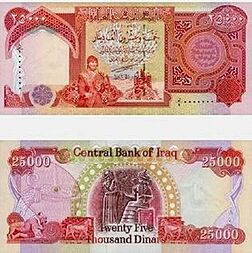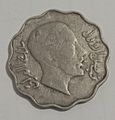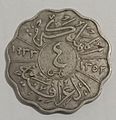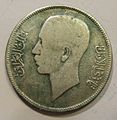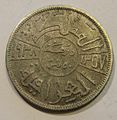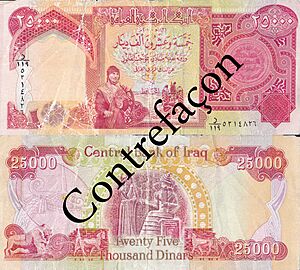Iraqi dinar facts for kids
Quick facts for kids Iraqi dinar |
|||
|---|---|---|---|
|
|||
| ISO 4217 Code | IQD | ||
| User(s) | |||
| Inflation | 1.79% | ||
| Source | Central Bank of Iraq, May 2015 | ||
| Subunit | |||
| 1⁄1000 | fils | ||
| Symbol | ID or د.ع | ||
| Banknotes | |||
| Freq. used | ID 250, ID 500, ID 1,000, ID 5,000, ID 10,000, ID 25,000 | ||
| Rarely used | ID 50,000 | ||
The Iraqi dinar (Arabic: دينار; sign: ID or د.ع; code: IQD) is the money used in Iraq. The Central Bank of Iraq creates and manages it. One dinar used to be worth 1,000 fils, but fils are no longer used because of inflation. On February 7, 2023, about 1,300 Iraqi dinars were equal to one US dollar.
Contents
History of the Iraqi Dinar
The Iraqi dinar started being used on April 1, 1932. It replaced the Indian rupee, which was the official money in Iraq after the British took control during World War I. One Iraqi dinar was worth 11 Indian rupees.
At first, the dinar was linked to the British Pound sterling. This meant its value was the same as the pound. In 1959, its value stayed the same, but it was linked to the United States dollar instead. At that time, 1 Iraqi dinar was worth US$2.80.
The dinar's value went up when the US dollar's value dropped in 1971 and 1973. It reached US$3.3778. Later, its value was lowered by 5%, making it US$3.2169. This value stayed until the Gulf War in 1990. However, by late 1989, people were selling dinars for much less on the unofficial market.
Changes After 1990
After the Gulf War in 1990, the United Nations placed restrictions on Iraq. This meant Iraq could no longer order high-quality banknotes from the British company De La Rue. So, Iraq started printing new money itself.
The older, high-quality notes were called Swiss dinars. The new notes, printed in Iraq, were called Saddam dinars. Because of international restrictions and a lot of new money being printed, the Saddam dinar quickly lost its value. By late 1995, US$1 was worth 3,000 Saddam dinars on the unofficial market.
The Swiss dinar notes continued to be used in the Kurdish regions of Iraq. The Kurdish government did not want to use the low-quality Saddam dinar notes. Since many Saddam dinar notes were printed, their value went down. But the supply of Swiss dinar notes stayed the same, so their value went up compared to the Saddam dinar. This helped the northern part of Iraq avoid the high inflation seen in the rest of the country.
After Saddam Hussein was removed from power in 2003, new Saddam dinar notes were printed. This was a temporary solution to keep money flowing until a new currency could be introduced.
New Dinar Notes from 2003
From October 15, 2003, to January 15, 2004, new Iraqi dinar notes and coins were released. These new notes were printed by De La Rue, a British company, using modern ways to prevent fake money. The goal was to create one type of money for all of Iraq.
Trillions of dinars were sent to Iraq to replace the old Saddam dinar notes. Saddam dinar notes were exchanged for the new dinars at the same value. Swiss dinar notes were exchanged at a rate of one Swiss dinar for 150 new dinars.
The value of the dinar has continued to change. On December 19, 2020, Iraq's Central Bank lowered the dinar's value by 24%. This was done to help the government's income, which was affected by the COVID-19 pandemic and low oil prices. On March 2, 2019, the exchange rate was about 1,190 dinars for US$1. By June 18, 2021, it was about 1,460.50 dinars for US$1.
Understanding Dinar Speculation
There is not much international demand for Iraqi dinars. Iraq mainly sells oil, which is paid for in US dollars. Because of this, the dinar often has a very low value compared to other currencies.
However, after Saddam Hussein was removed, many people started buying dinars. They hoped the dinar's value would greatly increase in the future. Some companies sold dinars at a very high price, promising big profits. This can be a real investment for currency traders, but it can also be a type of foreign exchange fraud. Some companies have been found guilty of fraud related to selling dinars.
This trading became popular again after Donald Trump was elected in 2016. Many buyers believed he would cause the dinar's value to rise sharply.
Experts like Keith Woodwell and Mike Rothschild explained that this speculation might come from a misunderstanding. The Kuwaiti dinar's value recovered after the First Gulf War. Some people thought the Iraqi dinar would do the same after Saddam's fall. However, Iraq and Kuwait are very different. Iraq has faced a lot of violence and relies almost entirely on oil.
Many government agencies and news groups have warned people about investing in the Iraqi dinar. They say there is no place outside Iraq to exchange the dinar. Dealers often sell them at very high prices. Also, there is little proof that the dinar's value will increase a lot. In 2014, the Better Business Bureau listed investing in the dinar as one of the top scams of 2013.
Iraqi Coins
Coins were first used in Iraq in 1931 and 1932. They came in different values: 1 and 2 fils (bronze), 4 and 10 fils (nickel). There were also 20, 50, and 200 fils coins made of silver. The 200 fils coin was also known as a rial.
During World War II, some 5 and 10 fils coins were made of bronze instead of nickel. Nickel was used again in 1953. Silver 100 fils coins were also introduced in 1953. These coins showed images of the kings of Iraq: King Faisal I, King Ghazi, and King Faisal II.
After Iraq became a republic, new coins were made in 1959. These included 1, 5, 10, 25, 50, and 100 fils. The 25, 50, and 100 fils coins were made of silver until 1969. Instead of a king's image, these coins showed a sun design. Later, in 1968, three palm trees were shown.
In 1970, 250 fils coins were introduced. Then, 500 fils and 1 dinar coins came out in 1982. Some coins from 1982 were special editions celebrating ancient Babylonian achievements. During this time, coins were often recognized by their shape. For example, 250 fils coins were eight-sided, 500 fils coins were square, and 1 dinar coins were ten-sided. Coin making stopped after 1990 because of the Gulf War and international restrictions.
In 2004, new coins were released in values of ID 25, ID 50, and ID 100. They were made of bronze, brass, and nickel-plated steel. Their design is simple, showing a map of Iraq with its main rivers.
| Value | Diameter | Weight | Composition | Obverse | Reverse |
|---|---|---|---|---|---|
| ID 25 | 17.4 mm | 2.5 g | Copper-plated steel | Words: "Central Bank of Iraq" and "25 dinars" | Outline map of Iraq with the two rivers |
| ID 50 | 22 mm | 4.34 g | Brass-plated steel | Words: "Central Bank of Iraq" and "50 dinars" | Outline map of Iraq with the two rivers |
| ID 100 | 22 mm | 4.3 g | Stainless steel | Words: "Central Bank of Iraq" and "100 dinars" | Outline map of Iraq with the two rivers |
Iraqi Banknotes

On March 16, 1932, the Iraqi government started issuing banknotes. They came in values of 1⁄4, 1⁄2, 1, 5, 10, and 100 dinars. These notes were printed in the United Kingdom. From 1932 to 1947, the banknotes could be exchanged for British pounds.
After 1947, the National Bank of Iraq issued the banknotes. Then, after 1954, the Central Bank of Iraq took over. 100 dinar notes stopped being made in the 1940s. However, the other values were used until 1978, when ID 25 notes were introduced.
In 1991, ID 50 notes were introduced, and ID 100 notes were brought back. Then came ID 250 notes in 1995 and ID 10,000 notes in 2002.
Banknotes made between 1990 and October 2003, plus an ID 25 note from 1986, showed a picture of former Iraqi President Saddam Hussein. After the 1991 Gulf War, Iraq's money was printed in Iraq and China. It was made with low-quality paper and poor printing methods. Some notes were even printed on machines meant for newspapers.
Because of these simple printing methods, the banknotes looked very different from each other. Some parts would be too light, others too dark. Sometimes, fake banknotes looked better than real ones. Some notes were cut badly, and some even had no serial numbers. Even though the dinar lost a lot of its value, the highest note printed until 2002 was ID 250.
In 2002, the Central Bank of Iraq issued an ID 10,000 banknote for large transactions. But people rarely accepted it because they worried about theft and fake money. This meant people had to carry many ID 250 notes for daily use. Smaller notes were almost worthless. So, Iraq mostly had only one type of banknote used widely.
The money printed before the Gulf War was often called the Swiss dinar. These notes were made in England and were much better quality than those printed later. After a while, the Iraqi government stopped supporting this old money. But it was still used in the Kurdish region of northern Iraq until it was replaced after the second Gulf War. During this time, the Swiss dinar kept its value, while the new money kept losing value.
In 2003, new banknotes were issued with six values: ID 50, ID 250, ID 1,000, ID 5,000, ID 10,000, and ID 25,000. Their designs were similar to notes from the 1970s and 1980s. An ID 500 note was added in October 2004. In the Kurdish regions, the ID 50 note is not used.
In March 2014, the Central Bank started replacing banknotes with improved versions. These new notes have special features to prevent fakes. They also have raised patterns for people who cannot see well.
In February 2015, the Central Bank announced that ID 50 notes would no longer be used after April 30, 2015. People with these notes were told to exchange them for ID 250 notes or higher at banks.
In November 2015, the Central Bank introduced a new ID 50,000 banknote. This was the first new value since 2003 and the largest ever printed. These notes do not show Saddam Hussein. They have words in Arabic, English, and Kurdish. They also have new security features. The notes show a map of Iraq with the Euphrates and Tigris rivers and the Great Mosque of Samarra.
Kingdom of Iraq Dinar Series (1932–1939)
| Kingdom Dinar Series | |||||
|---|---|---|---|---|---|
| Image | Value | Main Color | Description | ||
| Obverse | Reverse | Obverse | Reverse | ||
 |
 |
ID 1⁄4
(1932) |
Green and black | King Faisal I | |
 |
 |
ID 1⁄2
(1932) |
Red and black | King Faisal I | |
 |
 |
ID 1
(1932) |
Black and dark brown | King Faisal I | |
 |
 |
ID 1
(1939) |
Green and dark brown | King Faisal II as a child | Kingdom Coat of arms with 1 dinar written inside |
 |
 |
ID 5
(1932) |
Red and black | King Faisal I | |
 |
 |
ID 10
(1932) |
Dark brown and purple | King Faisal I | |
 |
 |
ID 100
(1932) |
Yellow red and black | King Faisal I | |
 |
 |
ID 100
(1939) |
Yellow Green and black | King Faisal II as a child | |
Swiss Dinar Series (1979–1986)
| Swiss Dinar Series | |||||
|---|---|---|---|---|---|
| Image | Value | Main Color | Description | ||
| Obverse | Reverse | Obverse | Reverse | ||
| ID 1⁄4 | Green | silo of basra | Date palms | ||
| ID 1⁄2 | Brown | the Arabic astrolabe | Spiral minaret of the Great Mosque of Samarra | ||
| ID 1 | Blue-green | A gold dinar coin | Mustansiriya Madrasah | ||
| ID 5 | Brown-violet and deep blue | Gelî Ali Beg and its waterfall | Al-Ukhaidir Fortress | ||
| ID 10 | Purple on blue and violet | Abu Ali Hasan Ibn al-Haitham | Al-manara al-hadba fi al-Mawsil (the hunchbacked tower of the Great Mosque of al-Nuri) | ||
| ID 25 | Green and brown | Horses | Abbasid Palace | ||
| ID 25 (1986) | Brown, green and black on blue | Saddam Hussein with Battle of al-Qādisiyyah in background | Al-Shaheed Monument | ||
1990–2003 Series
| 1990–2002 Series | |||||
|---|---|---|---|---|---|
| Image | Value | Main Color | Description | ||
| Obverse | Reverse | Obverse | Reverse | ||
| ID 1⁄4 (1993) | Green | Palm trees | Al-Bab al-wastaniy li-sur Baghdad (middle gate of the town wall of Baghdad) | ||
| ID 1⁄2 (1993) | Violet | Astrolabe | Great Mosque of Samarra | ||
| ID 1(1992) | Pink and green | A gold dinar coin | Mustansiriya Madrasah | ||
| ID 5 (1990; not issued) | Light red and pink | Saddam Hussein, buildings at Hatra, statuette of Ur-Nammu (2111 to 2094 BC), King of Ur | House (Mudhif) built by the marsh Arabs, or the Ma’dan, in southern Iraq, frieze from the Sumero-Akkadian period, eagle, found at Hatra, Sumerian weight stone ("duck weight"), golden head of a bull, decorating the front of a lyre covered with inlays | ||
| ID 5 (1992) | Red | Saddam Hussein | The Monument to the Unknown Soldier, King Hammurabi with the sun god Shamash | ||
| ID 10 (1990; not issued) | Blue | Saddam Hussein, palm trees, scene of the Tigris River | King Ashur-bani-pal galloping forward with bow and arrow, 645–635 BC | ||
| ID 10 (1992) | Blue-green | Saddam Hussein and Ishtar gate | Lamassu, Assyrian carving of a winged bull | ||
| ID 25 (1990) | Green | Horses | Abbasid Palace | ||
| ID 25 (1986) | Green-brown | Saddam Hussein & Battle of Qadisiyah | Al-Shaheed Monument | ||
| ID 25 (2001) | Green | Saddam Hussein | Ishtar gate / Lion_of_Babylon_(statue) | ||
| ID 50 (1991) | Pink and green | Saddam Hussein | Great Mosque of Samarra | ||
| ID 50 (1994) | Brown and blue | Saddam Hussein and the Al-Shaheed Monument | Saddam Bridge | ||
| ID 100 (1991) | Green and purple | Saddam Hussein | Hands of Victory (Swords of Qādisīyah) | ||
| ID 100 (1994) | Blue | Saddam Hussein and the Hisn al-Ukhaydir (Al-Ukhaidir Fortress) | Baghdad Clock | ||
| ID 100 (2002) | Blue | Saddam Hussein | Old Baghdad | ||
| ID 250 (1995) | Violet | Saddam Hussein and the Qadisiya hydroelectric dam | Liberty Monument, Baghdad | ||
| ID 250 (2002) | Violet | Saddam Hussein | Dome of the Rock | ||
| ID 500 (1995; not issued) | Light pink | Saddam Hussein, Baghdad tower (previously International Saddam Tower) | Bridge of 14 July over Tigris River, Baghdad | ||
| ID 10,000 (2002) | Pink and violet | Saddam Hussein, The Monument to the Unknown Soldier | Mustansiriya Madrasah, Arabic astrolabe | ||
2003–Present Banknotes
| 2003 Series | |||||
|---|---|---|---|---|---|
| Image | Value | Main Color | Description | ||
| Obverse | Reverse | Obverse | Reverse | ||
 |
 |
ID 50 | Purple | Grain silos at Basra | Date palms |
| ID 250 | Blue | An Astrolabe | Spiral minaret of the Great Mosque of Samarra | ||
| ID 500 | Blue-green | Dukan Dam on the Little Zab river | Lamassu, Assyrian carving of a winged bull | ||
| ID 1,000 | Brown | A gold dinar coin | Mustansiriya Madrasah, Baghdad | ||
| ID 5,000 | Dark blue | Gelî Ali Beg and its waterfall | Al-Ukhaidir Fortress | ||
| ID 10,000 | Green | Abu Ali Hasan Ibn al-Haitham | Great Mosque of al-Nuri (Mosul) | ||
| ID 25,000 | Red | A farmer holding a sheaf of wheat, a tractor and a gold dinar coin | Carving of the Code of King Hammurabi | ||
| 2013–2015 Series | |||
|---|---|---|---|
| Value | Main Color | Description | |
| Obverse | Reverse | ||
| ID 10,000 | Green | Sculptor Jawad Saleem's Monument of Freedom at Liberation Square (Nasb al-Hurriyah) in Baghdad | Al-manara al-hadba fi al-Mawsil (the hunchbacked tower of the Great Nurid mosque in Mosul) |
| ID 25,000 | Red | A farmer holding a jug, a tractor and a gold dinar coin | Carving of the Code of King Hammurabi |
| ID 50,000 | Brown | Water wheel on the Euphrates river, palm trees, Gali Ali Beg waterfall | Fishermen, traditional reed house of the Mesopotamian marshes, rivers Euphrates and Tigris rivers on map |
| 2018 Series | |||
|---|---|---|---|
| Value | Main Color | Description | |
| Obverse | Reverse | ||
| ID 1,000 | Brown | A representation of an Assyrian star, man on a boat, inscription "Enlisting the marshes and Heritage of South Iraq in the World Heritage List" | Mustansiriya Madrasah, Baghdad |
Exchange Rate Information
| Current IQD exchange rates | |
|---|---|
| From Google Finance: | AUD CAD CHF EUR GBP HKD JPY USD USD |
| From Yahoo! Finance: | AUD CAD CHF EUR GBP HKD JPY USD USD |
| From XE.com: | AUD CAD CHF EUR GBP HKD JPY USD USD |
| From OANDA: | AUD CAD CHF EUR GBP HKD JPY USD USD |
| From fxtop.com: | AUD CAD CHF EUR GBP HKD JPY USD USD |
See Also
 In Spanish: Dinar iraquí para niños
In Spanish: Dinar iraquí para niños
- British currency in the Middle East
- Central Bank of Iraq
- Economy of Iraq
- Iraqi art
- Iraqi Swiss dinar
- Jordanian dinar
- Kuwaiti dinar


